PACS: 03.65.Xp; 03.65.Ca; 73.43.Jn
1.Introduction
Series expansions in quantum mechanics that involve discrete sets of basis functions have proven to be powerful tools for describing wave amplitudes, propagators, and related physical quantities. Various species of basis functions (e.g. quantum box eigenfunctions, harmonic oscillator eigenfunctions, Hilbert-Schmidt basis, Kapur-Peierls basis) have been used in different physical applications1. A special set of basis functions that have proven to be very useful to expand Green’s propagators, and probability amplitudes, are the so called Gamow functions 2. In the context of quantum decay, they correspond to complex eigenfunctions of Schrödinger’s equation with purely outgoing boundary conditions. A number of advantages of their use in resonance expansions are listed in 3, among which one of the most important is the fast convergence of the resonance expansions. Along several decades, the properties and applications of Gamow states as basis functions have been the subject of investigation 3,4,5,6, mainly in the context of the theory of nuclear physics and scattering theory.
The notion of purely outgoing states was applied by Siegert7 to derive an analytical expression for the scattering cross section, relevant for the study of nuclear reactions. In the latter approach, the relationship between the scattering problem and the poles of the corresponding S-matrix is manifested. Further developments by Peierls 8 led to a more general expression for the scattering amplitude that involved an expansion in terms of the resonance poles and their corresponding residues. The proportionality between the Gamow states and the residues at the complex poles was demonstrated by García-Calderón et al.5 , leading to analytic expressions of continuum wave functions in terms o resonant states for three dimensional systems. These ideas where brought 9 to the context of electron transport in one-dimensional semiconductor heterostructures, introducing a representation of the Green’s function in terms of one-dimensional Gamow functions, and its crucial connection with the stationary wavefunction
The convergence properties of the expansion of the wavefunction
2. Resonance expansion for the internal wavefunction
2.1. Stationary case
The expansion of the outgoing Green’s propagator G+ in terms of resonant states and its connection with the scattering wave function are presented in detail in 15, and we shall recall here the main equations. The outgoing Green’s propagator G+ along the internal region of a one-dimensional finite range potential V(x) of arbitrary shape that extends on a finite spatial interval
along the closed contour
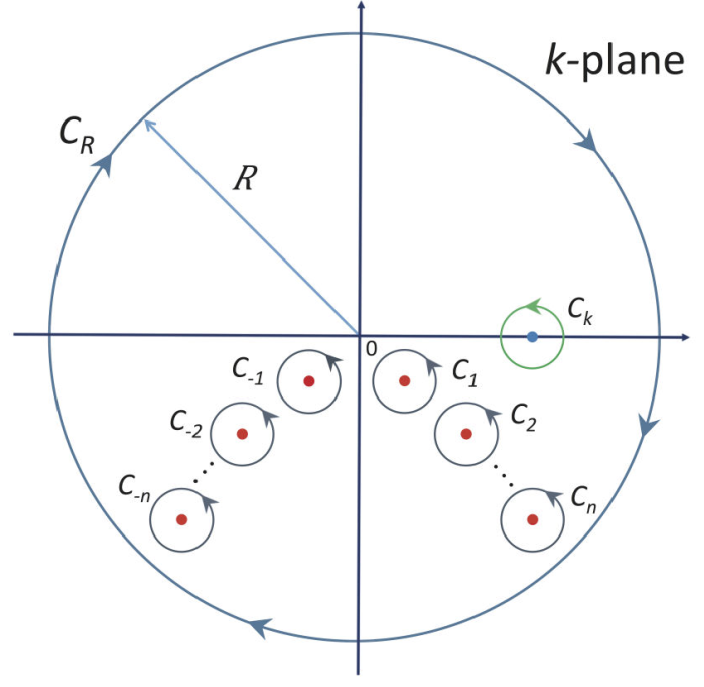
Figure 1 Closed contour C in the complex k-plane used to obtain the discrete resonance expansion of G + given by Eq. (3). The contour excludes all the complex poles of the integrand of Eq. (1), and is composed by the following contours: CR of radius R centered about the origin in the k-plane following a clockwise direction, and Ck that encloses the pole at k = k, and all the Cn that encircle the set of complex poles {k n} of G +, both in an anti-clockwise direction.
One may obtain the first two integral in Eq. (2) by using the residue theorem, and the fact that the residues rn at the complex poles of
where the index n runs on both the third (n < 0), and fourth (n < 0) quadrants. The
with outgoing boundary conditions:
This set of eigenfunctions
In order to obtain an expansion of resonance states
which combined with Eq. (3), leads to the resonance expansion for
As pointed out in 16, the above expansion does not apply for the case
which will be used in our numerical calculations, testing its accuracy for different values of N. The coefficients of the sum
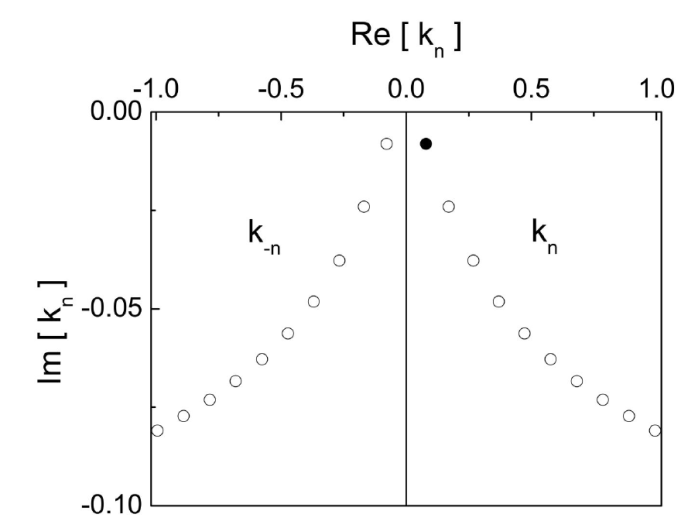
Figure 2 Distribution of the S-matrix poles of the system in the complex k-plane for a double delta potential with parameters: ¸ λ= 10:0 eV A° , and L = 30:0 A° . The poles of the third and fourth quadrant are related through -k-n
=
2.2. Dynamical case
Let us now consider the dynamical situation of incident particles on a resonant structure represented by the potential V(x). The calculation of the dynamical probability density
with
The analytical solution that involves a resonance state expansion (RSE) with explicit time dependence reads,
where
where
where q stands for
In practice, the evaluation of the dynamical solution, Eq. (11), is performed for a finite number of resonance terms N. For our numerical calculations,we define a solution
where
Equation (14) has been studied and applied mainly at the boundary point x = L since
Note that in the dynamical solution there are two kinds of convergence to be considered. One of them is its convergence to/ the stationary solution which is the asymptotic value that should be reached as
3. Results
We are interested here in analyzing the convergence of the resonance series expansions given by Eqs. (7) and (11) along the internal region of the system for stationary and dynamical descriptions, respectively. As an example, let us consider the exactly solvable problem of a particle of energy
The potential parameters are:
3.1. Stationary case
We now analyze the convergence speed of the RSE by exploring the probability density along the whole internal region of the system. In what follows we perform a comparison of the probability density calculated with the solution given by Eq. (8) for different values of N, and the exact solution
along the internal region. The latter is calculated by a standard approach of quantum mechanics that deals with the one-dimensional scattering of plane waves incidence from the left of the potential V (x) given by Eq. (15). The solution of Eq. (16) reads,
By computing the coefficients A (k) and B (k) by means of the well known transfer matrix technique we obtain the corresponding wavefunction for the internal region,
where we have defined
In order to measure the degree of proximity between the curves of the probability density computed with Eqs. (8) and (18) (a procedure that involves the comparison of a large number of points) we use a computational tool that provide us with a global estimate of the degree of convergence of the probability density computed from Eq. (8) in terms of a single parameter. We introduce such a parameter p as the (percentual) global degree of convergence between
where
Insofar, as
The values of the stationary probability density
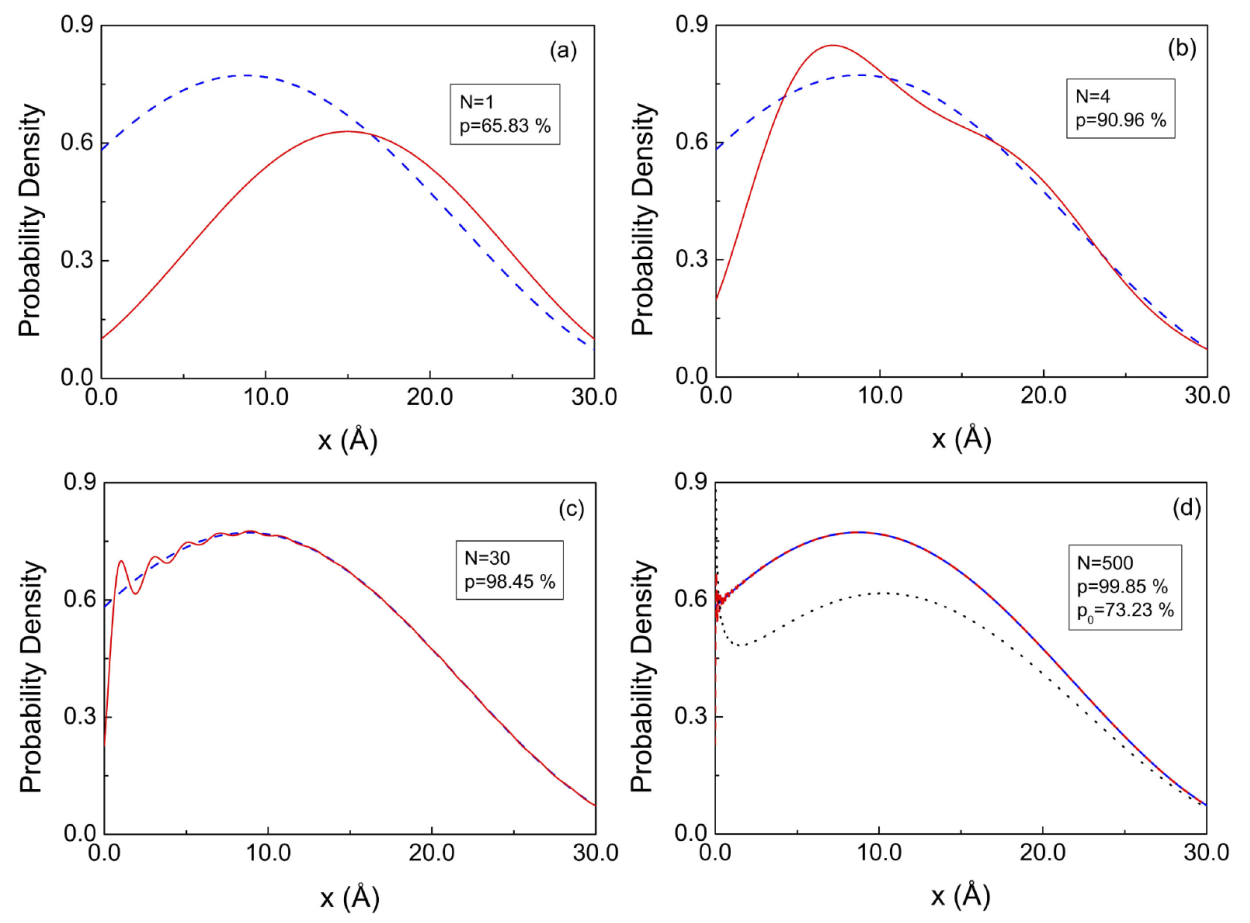
Figure 3 Comparison of the probability density of the approximate solution, Eq. (8) (red solid line), with the corresponding exact calculation, Eq. (18) (blue dashed line), at off-resonance incidence energy. The number N used in the expansion (8) and the value of p are indicated in the graphs. In (d), p is the value of po when the contribution of the poles k-n is not included (black dotted line).
The relative importance of the poles of the third and fourth quadrants in the complex k-plane, is further emphasized in Fig. 3 (d), where we have included an additional plot (black dotted line), which corresponds to the calculation of
We stress out however that there are situations in which the contributions of the third quadrant poles can be neglected. The simplest situation occurs when the incidence energy matches one of the resonances, say
Moreover, if the chosen resonance is sharp and isolated i.e.
may provide an excellent approximation.
To illustrate this case, let as consider a symmetrical double-delta resonator with stronger barriers and the incidence energy chosen at the first resonance,
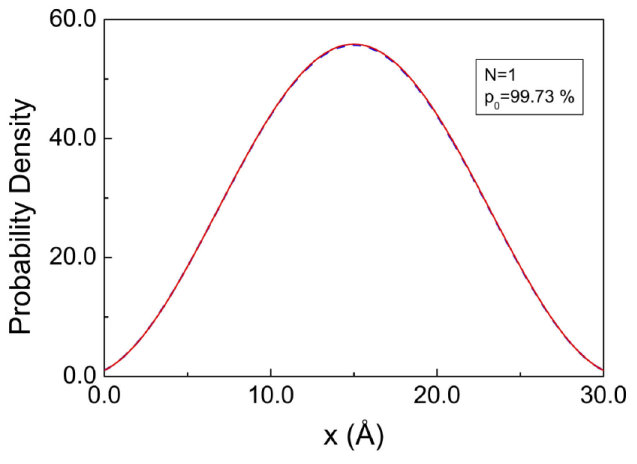
Figure 4 The one-term resonance expansion formula given by Eq. (22) (red solid line) accurately describes the exact calculation (blue dashed line) at resonance condition, E = ɛ1 . Even though the contribution of the pole k -1 is not included, the proximity p0 is almost 100%.
This shows that the additional contribution from the poles k -n of the third quadrant is not essential in this case. In the two examples discussed above, where we analyze the behavior of the resonance sum (8) as a function of N, the convergence proved to be more efficient in the system with a higher value of λL i.e. a smaller N is needed in order to accomplish a given value of p. It turns out that systems characterized by the same product λL exhibit an identical behavior, provided that the incidence energy is properly chosen. This is relevant because it can predict the behavior of families of systems with different λ and L but with the same product λL.
In order to illustrate the gradual increase of p with N, a p vs N plot is shown in Fig. 5 for the same double-delta system (which from now on we call system A), and same incidence energy (solid line). If the difference between the incidence energy and the nearest resonance is increased, more resonances are needed in the expansion to keep the proximity level. The p vs N plot for
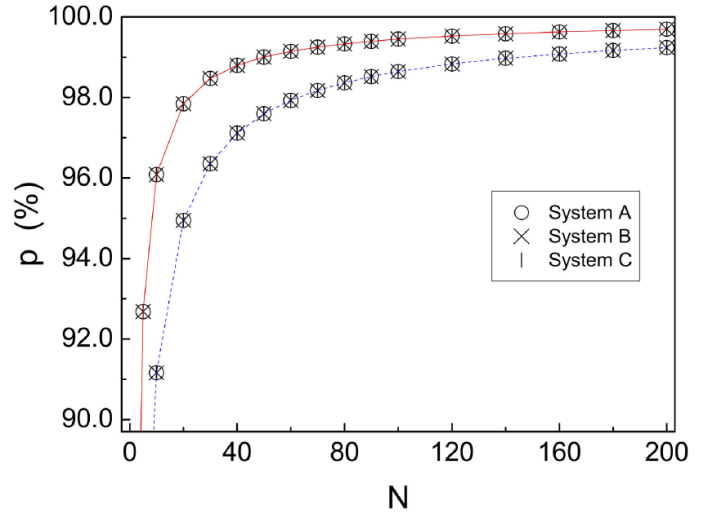
Figure 5 Behavior of p for different systems sharing the same product λL for incidence energies below the first resonance. The deviations from resonance are:
This numerical invariance is interesting by itself, and useful for the present study since it will enable us to characterize the convergence properties of the resonance expansion for all the systems with the same λL. As we show analytically in the Appendix, the above is regularities are explained in terms of a scaling property of the Schrödinger equation (valid for these potentials) that leaves invariant
3.2. Dynamical case
We are interested here in the analysis of the buildup process of the electronic probability density inside the system using the time-dependent solution given by the resonance expansion (14), which can describe the evolution of
As an example, let us consider the problem of a particle of energy E incident from the left (x < 0) on a symmetrical double delta potential [Eq. (15)], with the same system parameters as in Fig. 2. In order to study the probability density in the whole time-domain, we introduce an alternative solution based on a continuum wave expansion (CWE). The latter is based on a standard approach in quantum mechanics that has been used to explore numerically22, and analytically22 the dynamical aspects of sharp wavepackets in momentum space (cutoff plane waves) in potential barriers. In the present study we have adapted the method used by Brouard and Muga22 to analyze the dynamics in the well region of the double delta potential. We begin with the following expansion22 ,
that deals with an integration of the stationary wavefunction ϕ(x,k) along the internal region, in our example given by Eq. (18), with an expansion coefficient C(k,k′) defined as,
By substituting in Eq. (24) the initial condition
where ϵ is an infinitesimal positive number used to guarantee the convergence of the integrals in Eq. (24). We calculate the expression for
where P stands for the Cauchy Principal Value. After a few algebraic manipulations, we obtain the CWE time-dependent wave function along the internal region,
Both the RSE and the CWE dynamical solutions can describe the buildup process from the transient to the stationary regime through the evaluation of the electronic probability density
The values of the time-dependent probability density
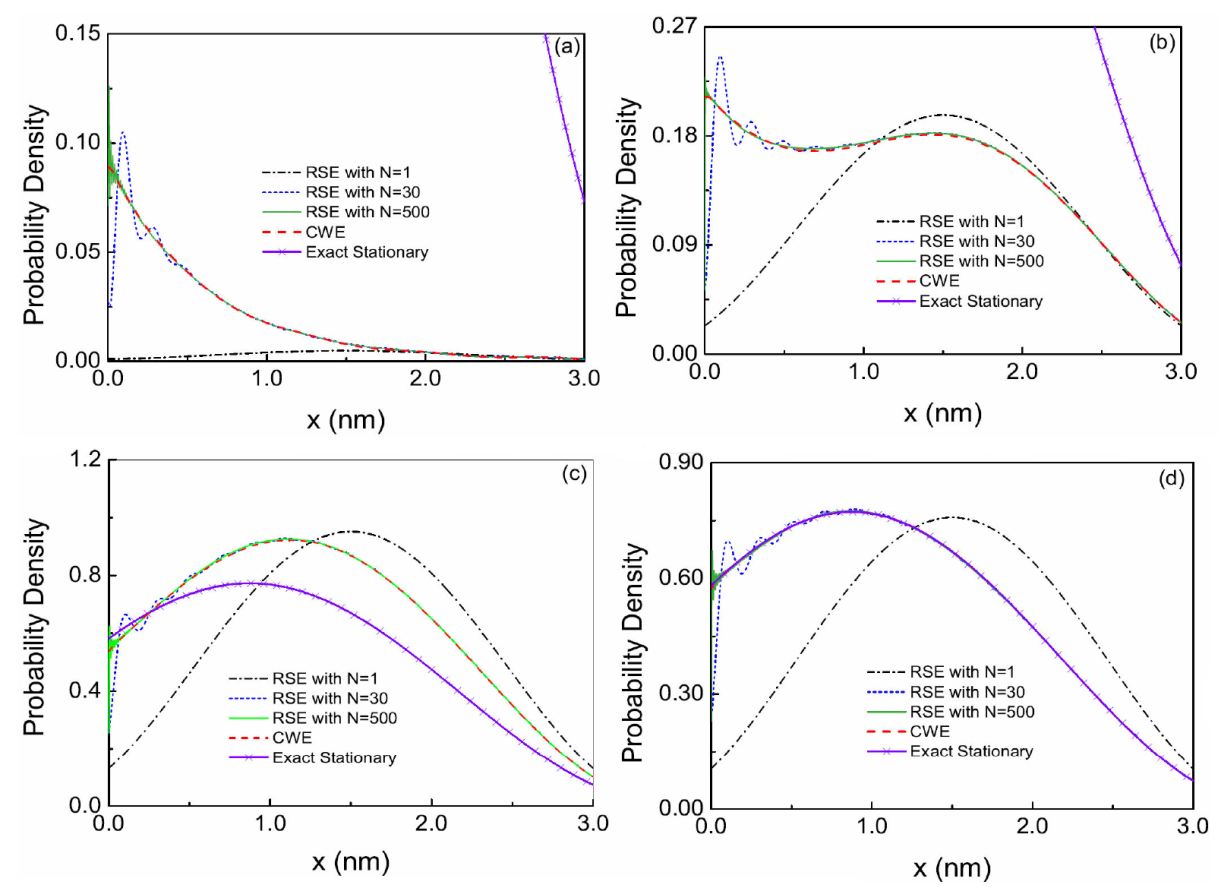
Figure 6 Comparison of the time-dependent probability density using the RSE of Eq. (14) for different number N of resonance terms with the calculation using the CWE of Eq. (27), at the fixed times: (a)
The calculation performed with the CWE approach, Eq. (27), is also included in these graphs (dashed red line) for the same chosen fixed times. As we can appreciate in each of these different graphs of Fig. 6, the resonance state expansion time-dependent probability density gradually converges around the asymmetric curve (CWE case) as N is increased. Since we are dealing with a scattering problem at off-resonance condition, it is expected that the resulting probability density inside the system becomes asymmetric. The symmetrical single resonance approximation, N = 1, is far from reproducing the probability density, specially at short times, as shown in Fig. 6 (a) where the contribution of the ground state becomes very small. This is because t = 0.1τ is only a small fraction of the corresponding lifetime and such a resonant state requires more time to be constructed inside the resonant structure, and the tunneling in this early stage is dominated by the higher resonances (N > 1) in a filtering process which privileges the passage of the faster components of the incident wave. As the number of resonance terms is increased to N =30, the RSE curves tend to reproduce the CWE calculation along the whole internal region of the potential except for the small oscillations (Gibbs phenomenon) near the left edge x = 0 of the system. For N = 500, these oscillations almost fade out and the RSE and CWE curves become numerically indistinguishable for long enough N. This is an interesting result not only because the formalisms beyond Eqs. (11) and (27) are quite different. A final snapshot is included in Fig. 6 (d) at t = 30.0τ, which is a sufficient long time that guarantees that the stationary situation is essentially reached at this time, as the transient regime typically extends over about ten lifetimes . Also in this asymptotic limit, the RSE and CWE calculations agree quite well for N = 500.
In order to compare with the stationary limit, we also included in each of the graphs of Fig. 6 the exact stationary probability density of the double delta potential calculated by the solution
The Gibbs phenomenon observed in the vicinity of x = 0 in the RSE curves for finite N is due to the fact that the Green’s function that led to the derivation of the series expansion of Eq. (7) is not defined at the point x = 0. However, as illustrated in Fig. 6, just by increasing the number N of resonance terms to a few tens (with the contribution of the third-quadrant poles included), an excellent description can be accomplished for x > 0.
The analysis presented so far illustrates the equivalence of RSE and CWE approaches in the calculation of the internal probability density in the full time domain from the transient to the stationary regime in a typical resonant structure. One of the advantages of the RSE approach is the possibility to handle analytical expressions that allows us to study the physics of the dynamical processes more deeply. With the RSE we can analyze separately the contribution of the individual resonant states to the buildup time scales. On the other hand, using the CWE, for a given position and time we integrate numerically Eq. (27) along the k-space and obtain a single numerical value of
4. Conclusions
The convergence of two resonance expansions, one stationary and the other dynamic, is analyzed in the calculation of the probability density in the internal region of a double-delta resonator. In the stationary case we investigate the equivalence of the solutions obtained by this approach, and the solution obtained by the standard continuum wave expansion method, finding that both approaches lead to results that are numerically indistinguishable from each other, provided that a relevant set of terms are included in the expansion. The importance of the anti-resonances (associated to the poles in the third quadrant) on the resonance expansion is also discussed. In particular, it is found that in the case of sharp and isolated resonances, and incidence at resonance, the contribution of the anti-resonances can be ignored. However, if the above condition is not satisfied, the contributions of the anti-resonances must be included in the solution in order to ensure convergence of the resonant expansion. We also demonstrate a useful scaling property that leaves invariant the Schrödinger’s equation and the resonance expansion, which allows us to characterize the degree of convergence of families of double delta systems with the same product λL.
In the dynamical case we used the time-dependent resonance expansion to calculate the probability density analyzing its convergence at different times within the transient regime, as well as in the asymptotic long time regime (stationary limit). In the short time regime, it is found that the main contribution to the solution comes from higher resonances N > 1 instead of from the ground state N = 1, in contrast to the stationary case where the lower state provide the main contribution. The above occurs as a consequence of the different time scale at which the resonance state contributes to the buildup of the wave function. The tunneling in these early stages is dominated by the higher resonances (N > 1) in a filtering process that privileges the passage of the faster components of the incident wave. In the limit of very long times, the time-dependent probability density evolves towards the stationary value, and becomes indistinguishable from the stationary case. As a final remark, we emphasize the fact that RSE approaches provide us with alternative ways to obtain reliable solutions in quantum transport problems. In addition to the above, we also have the advantage of deriving analytical expressions that allows us to analyze more deeply the underlying physics of the dynamical processes. In the particular problem studied here, we can analyze separately the contribution of the individual resonant states to the buildup time scales.











 text new page (beta)
text new page (beta)


